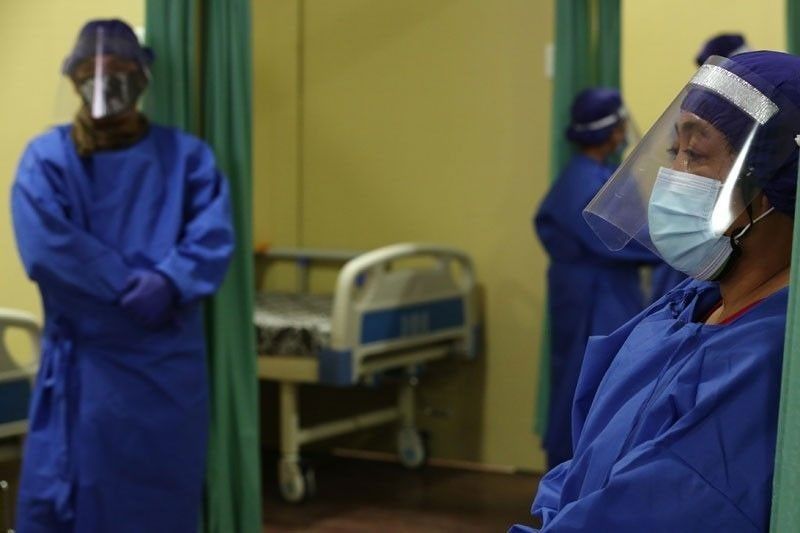Hospital Command Center seeing shortage of healthcare workers

MANILA, Philippines — Hospitals nationwide are suffering from manpower shortage due to rising COVID cases, according to the One Hospital Command Center.
OHCC operations chief Bernadette Velasco said the national government is sending additional healthcare workers (HCWs) to augment the workforce in regions with COVID surge.
“The same situation happened here in National Capital Region (NCR). We are seeing lack of manpower in regions where the surges are now,” Velasco said in an interview with “The Chiefs” aired over Cignal’s One News/TV5 on Wednesday night.
Although there is no available data on the manpower shortage, Velasco said that treatment of COVID doubles the requirement for HCWs.
“Because the COVID-19 approach is way different from a regular disease, the manpower would double or triple sometimes. Unlike in a regular disease you would just need one nurse. But for COVID, you need more manpower, that is why we are seeing a lack in manpower because of this pandemic,” Velasco said.
She cited Bicol, Iloilo City and Davao City as among the areas with a spike in COVID cases.
Critical and high risk areas for ICU or intensive care unit admissions included Davao region and Soccsksargen (South Cotabato, Cotabato, Sultan Kudarat, Sarangani and General Santos) while Bicol region, Caraga, Western Visayas and Zamboanga peninsula are classified under high risk.
Central and Eastern Visayas are at low risk classification.
To address the problem, Velasco said HCWs from regions with fewer cases are being deployed in identified high and critical risk areas.
She said mild and asymptomatic cases are also being transferred to isolation facilities to decongest hospitals.
Hospital equipment such as mechanical ventilator are sent by the national government to help regions needing additional ICU beds.
There are also OHCC in the regions under the national command center to assist patients needing hospitalization.
The OHCC is ready to tap the assistance of business process outsourcing (BPO) firms in case the surge continues.
“We have trained them, we haven’t used them, but if in case we experience the surge, we can easily tap and activate them,” Velasco said.
She said the regional OHCC have the directory of hospital facilities in their areas to immediately refer patients.
HCWs from regional hospitals and hospitals of the Department of Health as well the Bureau of Fire and Prevention (BFP), and the Philippine National Police are being tapped to augment areas experiencing manpower shortage.
Velasco said a surge of COVID cases in the Visayas and Mindanao requires that those areas be closely monitored.
“We are monitoring the cases, the bed occupancy as well as the medicine, equipment and supply,” Velasco said.
In Metro Manila, Velasco reported that ICU occupancy rate was between 44 to 52 percent in the past seven days.
“Meaning to say we are just in the low risk level in ICU occupancy, unlike during the surge when it really spiked to critical risk,” Velasco said.
Not full
Meanwhile, the DOH disputed reports that ICU beds in Metro Manila are full.
Health Undersecretary Leopoldo Vega said ICU utilization rate in the National Capital Region (NCR) remains at low risk.
“There are cities like Makati and Las Piñas where ICU utilization rate is at critical risk, but in general, utilization rate in Metro Manila is low,” Vega said.
Contrary to the pronouncement of the DOH, Philippine College of Physicians (PCP) vice president Maricar Limpin previously reported that ICU beds in NCR are full.
Limpin said the utilization rate for ICU beds in Metro Manila went up from 50 percent to 70 percent two weeks ago.
“A week ago or at least last week, it was 80 percent. Now we are 100 percent full,” Limpin said.
Yesterday, the DOH logged additional 6,637 cases, bringing to 1,339,457 the total number of confirmed COVID cases nationwide.
Of the total cases, 93.9 percent or 1,257,774 have recuperated, including 4,585 newly reported recoveries.
Active cases stand at 58,407 while the number of COVID-related fatalities rose to 23,276 including 155 additionaldeaths.
- Latest
- Trending
































